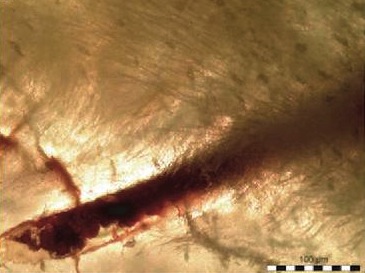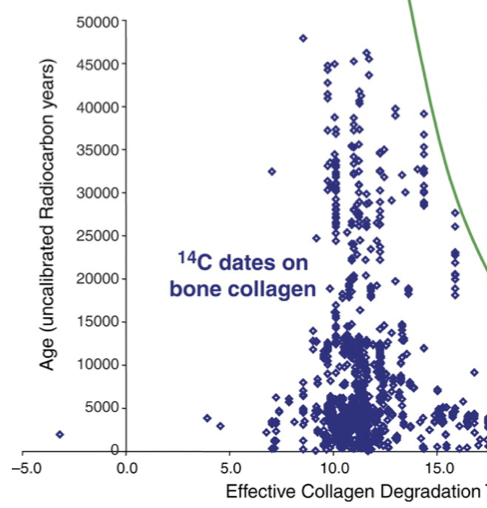RSF: Now Soft Tissue from a Mosasaur!
This is the show from Friday May 6th, 2011.
SUMMARY:

* Iron-clad Dinosaur-era Soft-tissue: Co-hosts Fred Williams and Bob Enyart talk about last week's stunning peer-reviewed report of yet another soft-tissue discovery (after such finds from a T. rex, a hadrosaur, and archeopteryx)! This time scientists from secular universities in Europe and America use sophisticated techniques to rule out modern contamination, and conclude that original biological material exists from a relatively small bone from an allegedly 70-million year old extinct marine reptile called a Mosasaur. The electron microscope was invented in 1931 and even from 1903 the ultramicroscope could study objects smaller than the wavelength of light. Thus more than a century of lost opportunity has passed with perhaps millions of fossils improperly handled because evolutionary bias has been so stifling that countless scientists likely never even considered looking for original biological material.

* Mosasaur Meets Real Science Friday: Bob asked long-time friend of BEL, Dave Willis from Indiana, to join the conversation about this latest news, reported also in Science Digest, May 2, 2011, for Dave has interacted at length with various scientists involved in the extraordinary discovery of proteins from what they call the Mesozoic Era. (As established by many proofs, see RSF's List of Not So Old Things, the Mesozoic Era was not an era but a rapidly deposited sedimentary layer.)

* Complete Collagen Decay Expected in Thousands of Years: Dave Willis and Fred Williams talk about the calculated maximum survival time of collagen, not in millions but in thousands of years, from a 2008 report in Science Magazine as it relates to the discoveries of soft dinosaur tissue.
* And Now, Amino Acids Line Up to show a Young Earth: Amino acids are not symmetrical and exist in equal proportions on earth in their right- and left-handed forms. However, living cells use only left-handed amino acids, and after death, an inexorable process of decay begins to randomize the handedness. Thus, with the peer-reviewed report from the Royal Society of London a decade ago mentioning the unfinished racemization of amino acids in dinosaur eggs, creationists have been eager to show that, as an additional confirmation that dinosaurs did not live millions but only thousands of years ago, that the amino acids in soft-tissue fossils will not have become randomized! And
Today’s Resource: You'll just love the science DVDs, books, and written, audio or video debates we offer through our Real Science Friday broadcasts! So have you browsed through our Science Department in the KGOV Store? Check out Bob most highly-recommended astronomy DVD, What You Aren't Being Told About Astronomy! And see Walt Brown’s great hardcover book, In the Beginning! You’ll also love Dr. Guillermo Gonzalez’ Privileged Planet (clip), and Illustra Media’s Unlocking the Mystery of Life (clip)! You can consider our BEL Science Pack; Bob Enyart’s Age of the Earth Debate; Bob's debate about Junk DNA with the infamous anti-creationist Dr. Eugenie Scott. And if you have young kids or grand kids, you owe it to them and to yourself to give them as a gift the SUPERB kids' radio programming on audio CD, Jonathan Park: The Adventure Begins! And Bob strongly recommends that you subscribe to CMI’s tremendous Creation magazine and if you're up to reading more technical scientific articles, you'll also want to subscribe to CRSQ! And to order any of our BEL science products by phone, just call us at 1-800-8Enyart (836-9278).
* Special Editions of Real Science Friday:
- BEL's famous List of Not-So-Old Things
- Bob's debate with Christian Darwinist British author James Hannam
- PZ Myers blogs against Real Science Friday so we hit back with the PZ Trochlea Challenge
- Waiting for Darwin's Other Shoe: Science mag cover: Darwin Was Wrong on the Tree of Life
- Microbiologist in Studio: Creation Research Society Quarterly editor on new genetic findings
- Caterpillar Kills Atheism: describe how a bug could evolve to liquefy itself and then build itself into a flying creature
- And see the RSF Offer of $2,000 to get 16 letters of the alphabet in their correct places; $500 paid in 1998; $1,500 in 2010...
This is the show from Friday May 6th, 2011.
SUMMARY:

* Iron-clad Dinosaur-era Soft-tissue: Co-hosts Fred Williams and Bob Enyart talk about last week's stunning peer-reviewed report of yet another soft-tissue discovery (after such finds from a T. rex, a hadrosaur, and archeopteryx)! This time scientists from secular universities in Europe and America use sophisticated techniques to rule out modern contamination, and conclude that original biological material exists from a relatively small bone from an allegedly 70-million year old extinct marine reptile called a Mosasaur. The electron microscope was invented in 1931 and even from 1903 the ultramicroscope could study objects smaller than the wavelength of light. Thus more than a century of lost opportunity has passed with perhaps millions of fossils improperly handled because evolutionary bias has been so stifling that countless scientists likely never even considered looking for original biological material.

* Mosasaur Meets Real Science Friday: Bob asked long-time friend of BEL, Dave Willis from Indiana, to join the conversation about this latest news, reported also in Science Digest, May 2, 2011, for Dave has interacted at length with various scientists involved in the extraordinary discovery of proteins from what they call the Mesozoic Era. (As established by many proofs, see RSF's List of Not So Old Things, the Mesozoic Era was not an era but a rapidly deposited sedimentary layer.)

* Complete Collagen Decay Expected in Thousands of Years: Dave Willis and Fred Williams talk about the calculated maximum survival time of collagen, not in millions but in thousands of years, from a 2008 report in Science Magazine as it relates to the discoveries of soft dinosaur tissue.
* And Now, Amino Acids Line Up to show a Young Earth: Amino acids are not symmetrical and exist in equal proportions on earth in their right- and left-handed forms. However, living cells use only left-handed amino acids, and after death, an inexorable process of decay begins to randomize the handedness. Thus, with the peer-reviewed report from the Royal Society of London a decade ago mentioning the unfinished racemization of amino acids in dinosaur eggs, creationists have been eager to show that, as an additional confirmation that dinosaurs did not live millions but only thousands of years ago, that the amino acids in soft-tissue fossils will not have become randomized! And
Today’s Resource: You'll just love the science DVDs, books, and written, audio or video debates we offer through our Real Science Friday broadcasts! So have you browsed through our Science Department in the KGOV Store? Check out Bob most highly-recommended astronomy DVD, What You Aren't Being Told About Astronomy! And see Walt Brown’s great hardcover book, In the Beginning! You’ll also love Dr. Guillermo Gonzalez’ Privileged Planet (clip), and Illustra Media’s Unlocking the Mystery of Life (clip)! You can consider our BEL Science Pack; Bob Enyart’s Age of the Earth Debate; Bob's debate about Junk DNA with the infamous anti-creationist Dr. Eugenie Scott. And if you have young kids or grand kids, you owe it to them and to yourself to give them as a gift the SUPERB kids' radio programming on audio CD, Jonathan Park: The Adventure Begins! And Bob strongly recommends that you subscribe to CMI’s tremendous Creation magazine and if you're up to reading more technical scientific articles, you'll also want to subscribe to CRSQ! And to order any of our BEL science products by phone, just call us at 1-800-8Enyart (836-9278).
* Special Editions of Real Science Friday:
- BEL's famous List of Not-So-Old Things
- Bob's debate with Christian Darwinist British author James Hannam
- PZ Myers blogs against Real Science Friday so we hit back with the PZ Trochlea Challenge
- Waiting for Darwin's Other Shoe: Science mag cover: Darwin Was Wrong on the Tree of Life
- Microbiologist in Studio: Creation Research Society Quarterly editor on new genetic findings
- Caterpillar Kills Atheism: describe how a bug could evolve to liquefy itself and then build itself into a flying creature
- And see the RSF Offer of $2,000 to get 16 letters of the alphabet in their correct places; $500 paid in 1998; $1,500 in 2010...
Last edited by a moderator:
